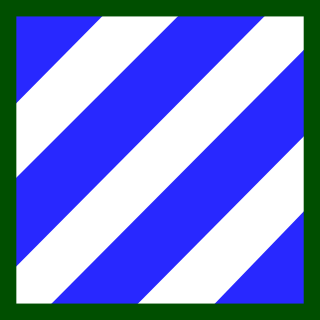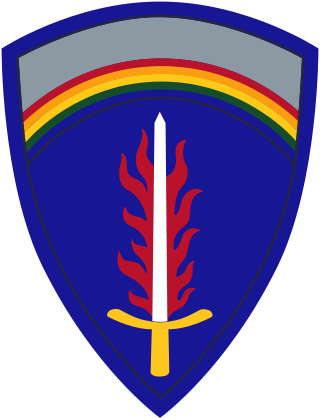
The 3rd Infantry Division (3ID) is a combined arms division of the United States Army based at Fort Stewart, Georgia. It is a subordinate unit of the XVIII Airborne Corps under U.S. Army Forces Command. Its current organization includes a division headquarters and headquarters battalion, two armored brigade combat teams, one aviation brigade, a division artillery, a sustainment brigade and a combat sustainment support battalion along with a maneuver enhancement brigade. The division has a distinguished history, having seen active service in World War I, World War II, the Korean War, and the Global War on Terror. The Medal of Honor has been awarded to 61 members of the 3rd Infantry Division, making the division the most honored in the Army.

The 1st Infantry Division (1ID) is a combined arms division of the United States Army, and is the oldest continuously serving division in the Regular Army. It has seen continuous service since its organization in 1917 during World War I. It was officially nicknamed "The Big Red One" after its shoulder patch and is also nicknamed "The Fighting First." The division has also received troop monikers of "The Big Dead One" and "The Bloody First" as puns on the respective officially sanctioned nicknames. It is currently based at Fort Riley, Kansas.

The 4th Infantry Division is a division of the United States Army based at Fort Carson, Colorado. It is composed of a division headquarters battalion, three brigade combat teams, a combat aviation brigade, a division sustainment brigade, and a division artillery.

The 5th Infantry Division (Mechanized)—nicknamed the "Red Diamond", or the "Red Devils" —was an infantry division of the United States Army that served in World War I, World War II and the Vietnam War, and with NATO and the U.S. Army III Corps. It was inactivated on 24 November 1992 and reflagged as the 2nd Armored Division.

The 6th Infantry Division was an infantry division of the United States Army active in World War I, World War II, and the last years of the Cold War. Known as "Red Star", it was previously called the "Sight Seein' Sixth".

The 85th Infantry Division also known as "Custer Division" was an infantry division of the United States Army in World War I and World War II. It currently exists as the 85th Support Command.
The 2nd Brigade Combat Team, 1st Infantry Division, also known as the Dagger Brigade, is a maneuver brigade combat team in the 1st Infantry Division of the U.S. Army stationed in Fort Riley, Kansas.

The 37th Infantry Brigade Combat Team (Buckeye) is an infantry brigade combat team of the United States Army National Guard with the brigade headquarters, cavalry squadron, field artillery battalion, engineer battalion, one infantry battalion, and support battalion stationed in Ohio, one infantry battalion and military intelligence company stationed in Michigan, and a third infantry battalion stationed in South Carolina. The headquarters of the 37th IBCT traces its lineage and honors back to the headquarters of the 37th Infantry Division.

The 181st Infantry Brigade is an infantry brigade of the United States Army based at Fort McCoy, Wisconsin. As a First Army brigade, the unit serves primarily in a partnering and training role for Reserve Units. The brigade is subordinate to the First United States Army, headquartered at Rock Island Arsenal, Illinois. It has ten subordinate battalions.

The 177th Armored Brigade is an AC/RC unit based at Camp Shelby, Mississippi. The unit is responsible for training selected United States Army Reserve and National Guard units. The unit was formerly designated as 3rd Brigade, 87th Division. The brigade is a subordinate unit of First Army.
The 229th Aviation Regiment is an aviation unit of the United States Army.
The 70th Armor Regiment is an armored (tank) unit of the United States Army. It was constituted as the 70th Tank Battalion in July 1940, an independent tank battalion intended to provide close support to infantry units. In this role, it saw action in the Mediterranean and European Theater of Operations, making assault landings and fighting with the 9th Infantry Division in North Africa, and with the 1st Infantry Division in Sicily. The battalion supported the 4th Infantry Division on Utah Beach during the D-Day landings in France, and fought with the 4th Infantry Division through the remainder of World War II. The 70th Tank Battalion was one of the first three tank battalions to deploy to Korea in the Korean War, where it saw significant action, primarily with the 1st Cavalry Division.

The 52nd Infantry Regiment is an infantry regiment of the United States Army.

The 1st Brigade, 24th Infantry Division was an infantry brigade of the United States Army. Before its most recent deactivation in 2006, it was based at Fort Stewart, Georgia. It was a divisional brigade of the 24th Infantry Division.

The 51st Infantry Regiment is a regiment of the United States Army first established in 1917.

United States Army Europe and Africa (USAREUR-AF) is an Army Service Component Command (ASCC) /Theater Army responsible for directing United States Army operations throughout the U.S. European Command (EUCOM) and U.S. Africa Command (AFRICOM) area of responsibility.
The 125th Infantry Regiment, Michigan Army National Guard, is a regiment under the U.S. Army Regimental System, with headquarters now in Saginaw, Michigan. The regiment currently consists of the 1st Battalion, 125th Infantry, an infantry battalion in the 37th Infantry Brigade Combat Team.

The 337th Infantry Regiment was an American National Army Infantry Regiment first organized for service in World War I as part of the 85th Division. It later served in the Mediterranean Theater during World War II. Since then it has served as a training regiment, training Army Reserve and Army National Guard soldiers for overseas service.
The 340th Infantry Regiment was a National Army unit first organized for service in World War I as part of the 85th Infantry Division in Europe. Since then it has served as a training regiment, training Army Reserve and Army National Guard soldiers fighting in the War in Afghanistan (2001-2021) and the War in Iraq.
The 338th Infantry Regiment was a National Army Infantry Regiment first organized for service in World War I as part of the 85th Infantry Division in Europe. It later served in the Mediterranean Theater during World War II. Since then it has served as a training regiment, training Army Reserve and Army National Guard soldiers for overseas service after the September 11 terrorist attacks.















